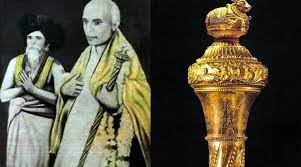On May 25, Union Finance Minister Nirmala Sitharaman addressed journalists in Chennai, shedding light on the historical significance of the sceptre (sengol) that is set to be installed in the new Parliament building. She emphasized how this sacred object, crafted by the Thiruvavaduthurai Adheenam in Tamil Nadu, represents a matter of pride for the state and the nation as a whole. Sitharaman reiterated that the ceremonial presentation of this sceptre to India’s first Prime Minister Jawaharlal Nehru on the eve of Independence symbolized and sanctified the pivotal “transfer of power” from the British Empire to independent India.
The Symbolic Transfer of PowerSitharaman eloquently recounted the event in which the sceptre was handed over to Jawaharlal Nehru, highlighting its profound significance in India’s journey towards self-rule. She emphasized that the sceptre itself embodied the essence of power and authority, signifying the sovereign rights that were being conferred upon the Indian people. The ceremony served as a poignant reminder of the momentous transition India was undergoing, from being a colony under British rule to becoming an independent nation.
The sceptre holds a deep-rooted historical significance that traces back to Tamil Nadu’s rich cultural heritage. Crafted by the skilled artisans of Thiruvavaduthurai Adheenam, a revered religious institution in Tamil Nadu, the sceptre represents the artistic prowess and craftsmanship of the state. It showcases the intricate detailing and cultural symbolism that have been an integral part of Tamil Nadu’s artistic traditions for centuries.
The ritual of presenting the sceptre to Jawaharlal Nehru in 1947 was a pivotal moment that marked the transfer of power from the British Empire to India. Sitharaman emphasized that this gesture not only symbolized the physical handover of authority but also represented the transfer of responsibility and the birth of a new democratic era. The act reinforced the unity and diversity of India, highlighting the collective effort of all states, including Tamil Nadu, in achieving independence.
Sitharaman proudly acknowledged Tamil Nadu’s significant role in India’s freedom struggle and its contribution to the country’s political and cultural landscape. The craftsmanship and cultural heritage of the state have left an indelible mark on the national identity. By crafting the sceptre, the Thiruvavaduthurai Adheenam played a crucial role in commemorating this historic moment and preserving the cultural legacy of Tamil Nadu.
The installation of the sceptre in the new Parliament building holds immense symbolic value. It not only represents the continuity of democratic governance but also serves as a reminder of India’s rich heritage and the sacrifices made by freedom fighters. The new Parliament building itself stands as a testament to India’s progress and aspirations for a better future.
The address by Union Finance Minister Nirmala Sitharaman in Chennai highlighted the historical significance of the sceptre that is set to be installed in the new Parliament building. She emphasized Tamil Nadu’s role in the symbolic transfer of power and how the sceptre, crafted by the Thiruvavaduthurai Adheenam, represents a matter of immense pride for the state. The ceremony of handing over the sceptre to Jawaharlal Nehru on the eve of Independence symbolized the transfer of authority and the birth of a new era for independent India. By acknowledging Tamil Nadu’s contribution to the country’s freedom struggle and cultural heritage, Sitharaman highlighted the unity and diversity that underpins the Indian nation. The installation of the sceptre in the new Parliament building serves as a powerful reminder of India’s journey and aspirations for a better future.


